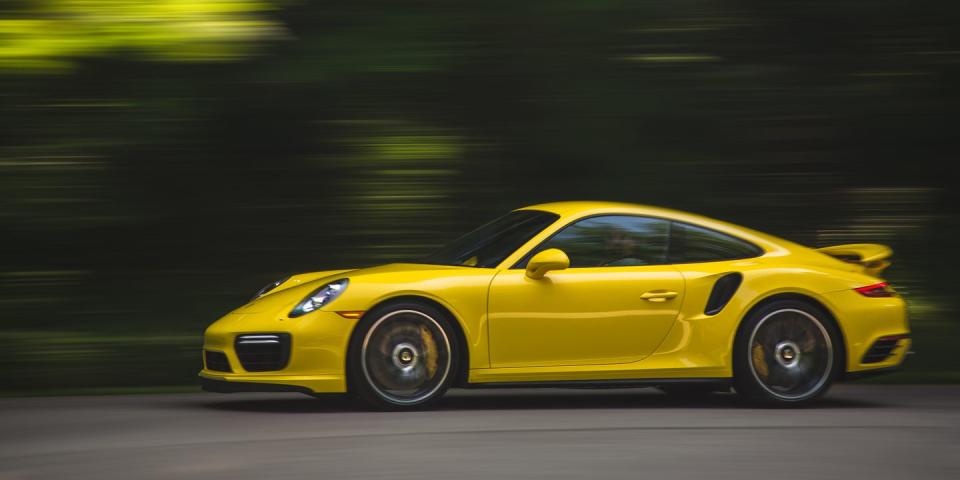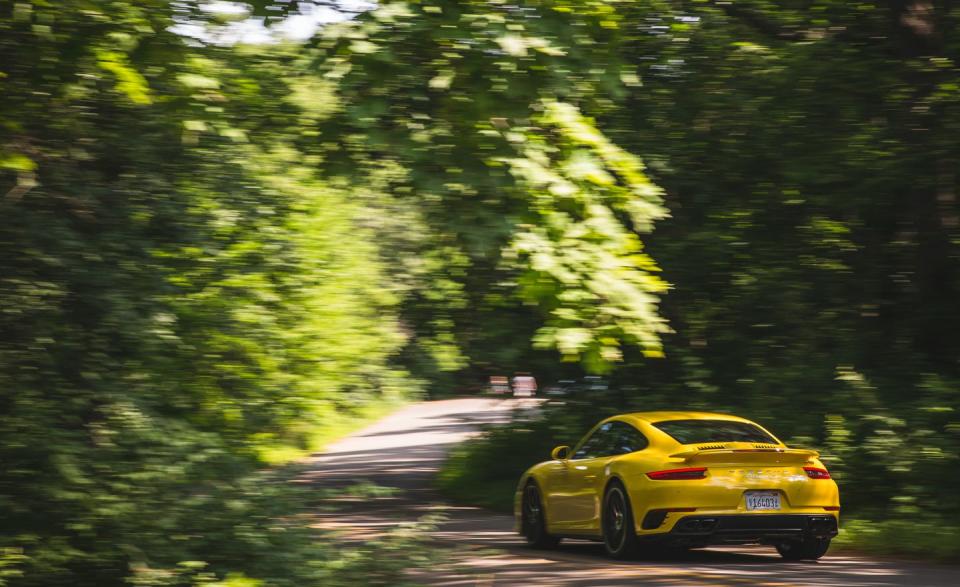2018 Porsche 911 Turbo S: Mega Speed in Surprising Comfort

It's claimed that more than 1200 varieties of sausage are available in Germany. An impressive feat of charcuterie, the country's diverse selection of encased meats has been referred to as the gastronomic equivalent of flourishing regional dialects. Peter Peter, the aptly named food correspondent of the equally aptly named Frankfurter Allgemeine Zeitung (Frankfurt General Newspaper), has gone so far to refer to the diversity of wurst as "history on the plate." What, exactly, this has to do with the Porsche 911 Turbo S is nothing and everything. While Porsche works in a different medium, it clearly shares the nation's penchant for crafting numerous flavors from a single, simple blueprint.
Broadly speaking, the all-wheel-drive Turbo S resides above the regular Turbo, GTS, and Carrera models in the sprawling 911 hierarchy, but the distinctions are far more nuanced. Producing 580 horsepower and 553 lb-ft of torque (40 horsepower and 67 lb-ft more than the non-S Turbo), the Turbo S is second only to the hairy-scary 700-hp rear-wheel-drive 911 GT2 RS in maximum engine output. But again, the GT cars serve different tastes and purposes rather than compete directly. Parked next to a spicy and bewinged GT2 RS or GT3 RS, the Turbo S appears rational-sensible, even. The Racing Yellow paint worn by our test example simply serves as a user-selected condiment.
Blinding Performance
Let us not underplay the Turbo S's blinding performance. And by blinding, we mean the first time you use launch control it takes a moment for your eyes and inner ear to reconcile the corporeal inputs. Select Sport+ mode, turn off the stability control, depress the brake, depress the accelerator, lift the brake pedal for launch, and prepare for the 911 Turbo S's unique take on the theme of acceleration: a tidy, controlled, and extremely rapid accumulation of speed. As one editor advised, "Make sure to have your head resting against the headrest before trying launch control." Wheelspin and chassis squat are negligible, as speed gathers without the histrionics generally associated with cars capable of running a sub-11-second quarter-mile. Once familiarized, we managed to punt the Turbo S to 60 mph in just 2.7 seconds and through the quarter-mile in 10.7 seconds with a trap speed of 130 mph.
We've sampled a smorgasbord of 911s of late, and here's how they stack up in terms of acceleration: The 911 Carrera T with the seven-speed manual was one full second slower to the 60-mph mark and 1.4 seconds pokier in the quarter-mile with a trap speed of 118 mph. The naturally aspirated GT3 with a seven-speed manual was also a full second slower to 60 and required an additional 1.8 seconds to complete the quarter-mile with a trap speed of 125 mph. An automatic GT3 fared better, reaching 60 mph in an even 3.0 seconds and completing the quarter in 11.1 seconds at 127 mph. But the king is the GT2 RS, beating the all-wheel-drive Turbo S with its 2.6-second zero-to-60-mph dash and quarter-mile run of 10.3 seconds with a 140-mph trap speed. Of course, feasting on the GT2 RS will set you back at least an additional $130K, but variety, as they say, is the spice of life-right?
Despite its straight-line prowess, the 911 Turbo S has an exhaust note that is a paragon of deportment compared to the sonic overload produced by the naturally aspirated engine in the GT3, the manual version of which registered 100 decibels in the cabin at wide-open throttle-the Turbo S registered 84 decibels. When cruising along the highway at 70 mph, the interior noise level in the Turbo S is a very pleasant 76 decibels.
A Chassis to Match
To ensure stopping power commensurate with its accelerative capabilities, Porsche fits the Turbo S with its third-generation Porsche Ceramic Composite Brake (PCCB) system as standard (it's optional on the non-S Turbo). Comprising 16.1-inch rotors with six-piston calipers in front and 15.4-inch rotors with four-piston units in the rear, it provided enough bite to haul our Turbo S to a stop from 70 mph in just 133 feet. More than just capable, once warmed they deliver enough feedback that a driver can interpret even the most gentle applications of the pedal with near-telepathic results.
Serving up 1.12 g of lateral grip and remarkable agility dialed in via steering that's quick but never twitchy, the Turbo S nonetheless can relax and offer a calming environment generally not associated with vehicles capable of such dynamic derring-do. The interior materials are of quality, and the purposeful design is devoid of flash, although some of the switchgear requires familiarization. Seating is a near-perfect blend of comfort and support, and once properly adjusted the seats essentially disappear, allowing the driver to focus on the task of driving.
Both familiar yet so very contemporary, the 911 Turbo S again validates Porsche's ability to take its time-honored smorgasbord of hardware, blend in some fresh seasonings, and put it in a familiar casing without genericizing the flavor. The price for this special brand of magic is steep-our car's $193,440 bottom line is a significant chunk of change for even the most dedicated Porschephile. That many of the same sensations are available in 911 variants for as much as $100K less is a valid point, but the world has enough processed bulk-pack hot dogs and store-brand sodas on offer. The 911 Turbo S offers automotive flavor we'd stand in line for any day.
('You Might Also Like',)

 Yahoo Autos
Yahoo Autos 

